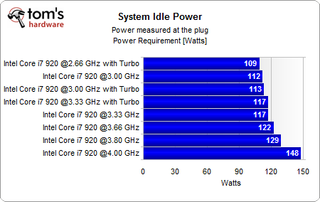Overclocking Core i7: Power Versus Performance
Idle/Peak Power Consumption Analysis

The idle power consumption was measured with SpeedStep enabled, meaning that the processor switched to the x12 multiplier and reduced clock speed in all cases. Since idle clock speed and power are always measured at x12, the resulting clock speed stays between 1.6 GHz (133 MHz base clock) and 2.4 GHz (200 MHz base clock). All of this is still well below what we’d considered critical or even high for clock speed, which results in still-acceptable power consumption when idle.
It’s interesting to see that 3.0 or even 3.33 GHz instead of 2.66 GHz equals a 13% or 25% clock speed increase respectively, and that this increase comes at matching system power consumption increases of roughly 3% and 7.3%. Going to 3.66 GHz at increased voltage still doesn’t inflate the idle power level, but going to 4.0 GHz does. Although the 50% clock speed increase results in a 36% increase in idle power, this means that you’ll be running at increased power requirements without getting a lot of benefit at idle.

Peak power is the real deal. While the Core i7 920 requires 213 W system peak power in our configuration—representing a 104 W increase over idle power—the overclocked settings require up to 45% more peak power at up to 3.8 GHz.
| Core i7 920 (2.66 GHz / 213 W Peak Power) | Performance Increase | Average Power Increase |
|---|---|---|
| 3.0 GHz | 13% | 8% |
| 3.33 GHz | 25% | 18% |
| 3.66 GHz | 37.5% | 24.4% |
| 3.8 GHz | 42.5% | 45.5% |
| 4.0 GHz | 50% | 95.7% |
Obviously, the peak power exceeds the clock speed increase at roughly 3.7 GHz clock speed. Although this lineup is not exactly relevant in real life, it will be interesting to see if this applies to a real benchmark.
Stay on the Cutting Edge
Join the experts who read Tom's Hardware for the inside track on enthusiast PC tech news — and have for over 25 years. We'll send breaking news and in-depth reviews of CPUs, GPUs, AI, maker hardware and more straight to your inbox.
Current page: Idle/Peak Power Consumption Analysis
Prev Page Benchmark Results: Audio/Video Next Page Average And Total Power During PCMarkMost Popular

